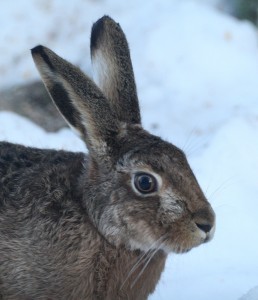 Brown hares are, perhaps, one of the most mysterious of animals in the countryside and there are still some aspects we do not fully understand. They also figure in folk-lore and myth more than any other animal, perhaps partly because they can be so secretive. One now explained mystery is the concept of the “Mad March Hares”, as in that month hares can be seen coming together in twos, often more, with two of them actively fighting. They do this by rearing up on their hind legs and simply boxing. It was long thought that this was two males fighting over nearby females. Now it is known that the two animals are a Jack and a Jill with the aggression coming from the female which is resisting the males advances until she is quite ready for mating. In fact “Mad March Hare” is a misnomer as the can mate any time between mid-February and mid- September.
Brown hares are, perhaps, one of the most mysterious of animals in the countryside and there are still some aspects we do not fully understand. They also figure in folk-lore and myth more than any other animal, perhaps partly because they can be so secretive. One now explained mystery is the concept of the “Mad March Hares”, as in that month hares can be seen coming together in twos, often more, with two of them actively fighting. They do this by rearing up on their hind legs and simply boxing. It was long thought that this was two males fighting over nearby females. Now it is known that the two animals are a Jack and a Jill with the aggression coming from the female which is resisting the males advances until she is quite ready for mating. In fact “Mad March Hare” is a misnomer as the can mate any time between mid-February and mid- September.
Unlike rabbits, brown hares live entirely above ground and rely on their camouflage to stop them being seen. In open situations such as fields they crouch in what has a special name, a “form”, which is merely a depression in the grass or heather. When a hare is in this form it crouches down with its long ears flat and is very difficult to see. From a distance it looks just like a stone or brown clod of earth. In many cases such is the attachment to this form that you can walk right past the crouching hare without it moving. In the woodland haunts the hare just blends in with its surroundings and, whilst it does make a form the tall vegetation also gives it plenty of camouflage.
This means that for the naturalist there must be signs to look for. Hares in open fields often use pre-determined routes and the slightly flattened runs can be seen once you know what to look for. If a hare does leave its form you can feel the warmth with your hand in the bottom of the depression. Fortunately the hare tracks are easy to identify and, unusually, this is even the case when the hare has gone through deep snow. The reason is that at the back there are two tracks, one directly behind the other and then, in front of those, two tracks side by side and close together. The two rear tracks are, in fact, the front paws and then the two hind feet are brought forward on either side of the hare to form the two side by side. This combination is unusual and this is true whether the hare is walking or running. One former mystery of the hares’ tracks is why suddenly the hare would leap far to one side and then turn back on its route. Observations showed that this is to fool any predator that may be following the tracks.
The collective noun for a group of hares is a “down” or “husk” although the origin of these names is unknown. There are a number of Gaelic names with one being “gearr” and the leverets also have a few names such as “ gearrag”. Although Jack and Jill are the common names for the male and female, they are termed in many sources as a buck and a doe. The terminology does not stop there as even the tracks have names as in sand or mud the tracks are called a “sore” and even more unusual is that the hare tracks in the snow are called a “trace”.
Tags: highland wildlife
